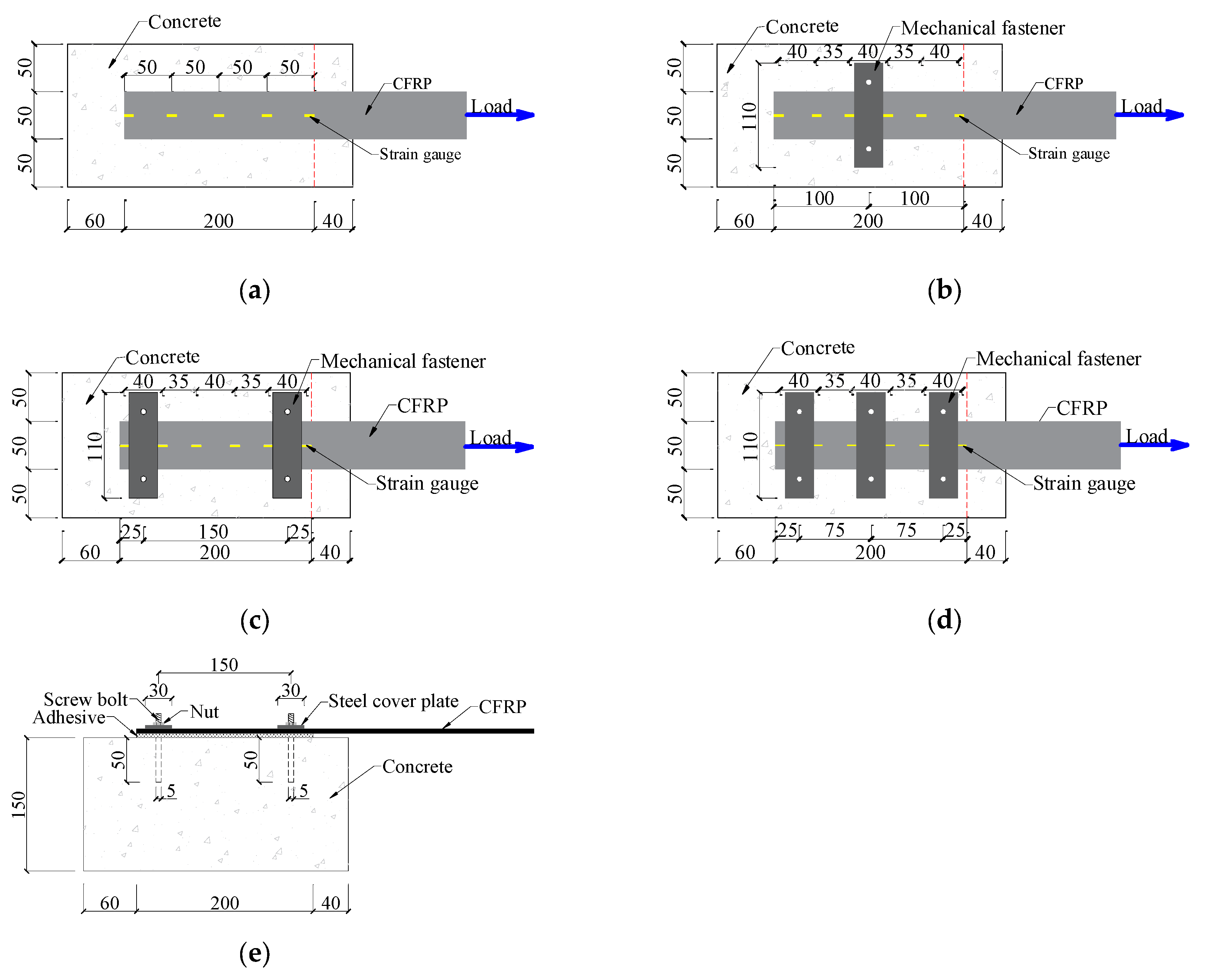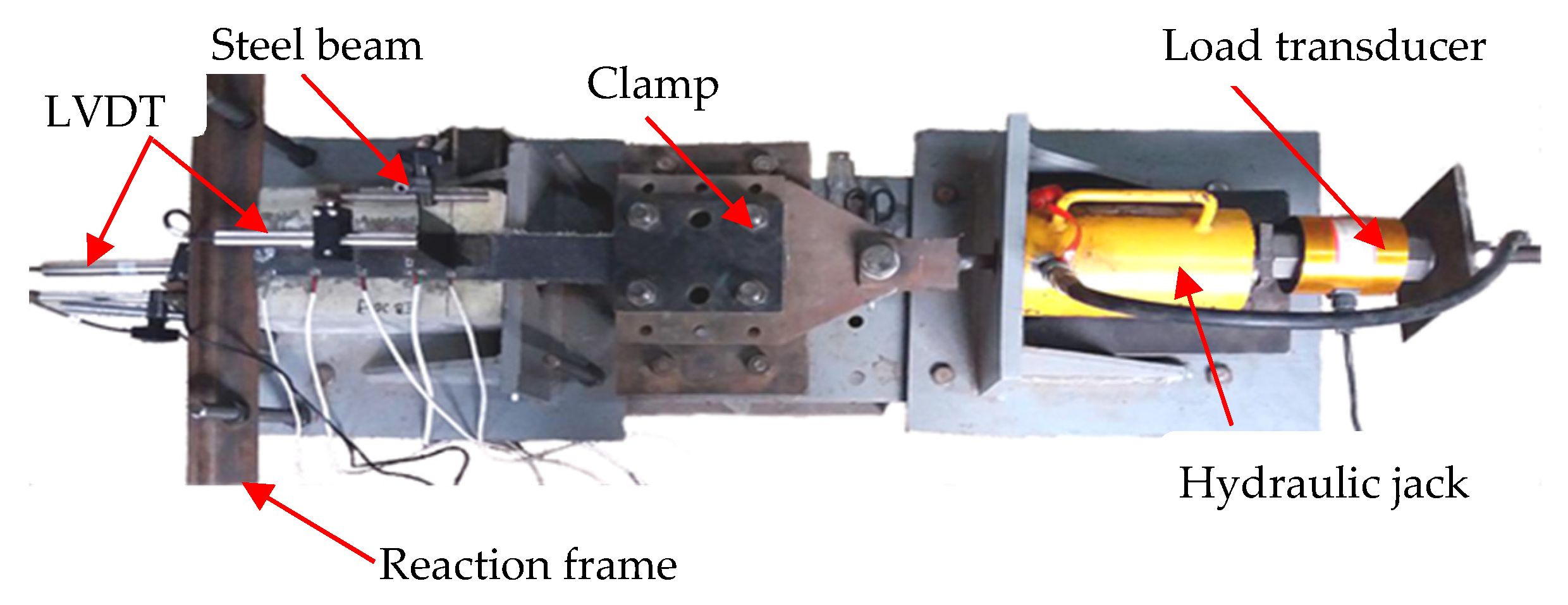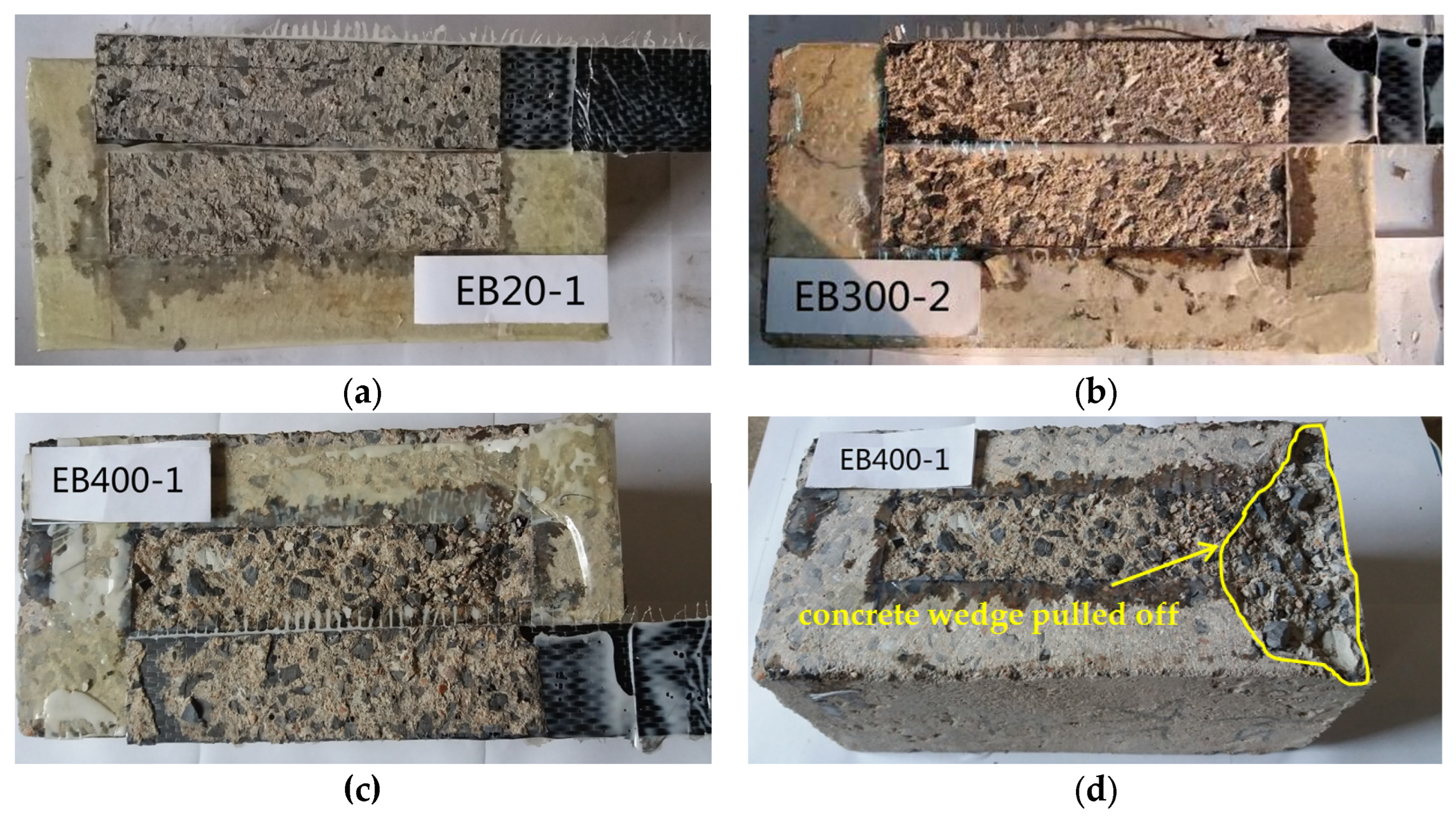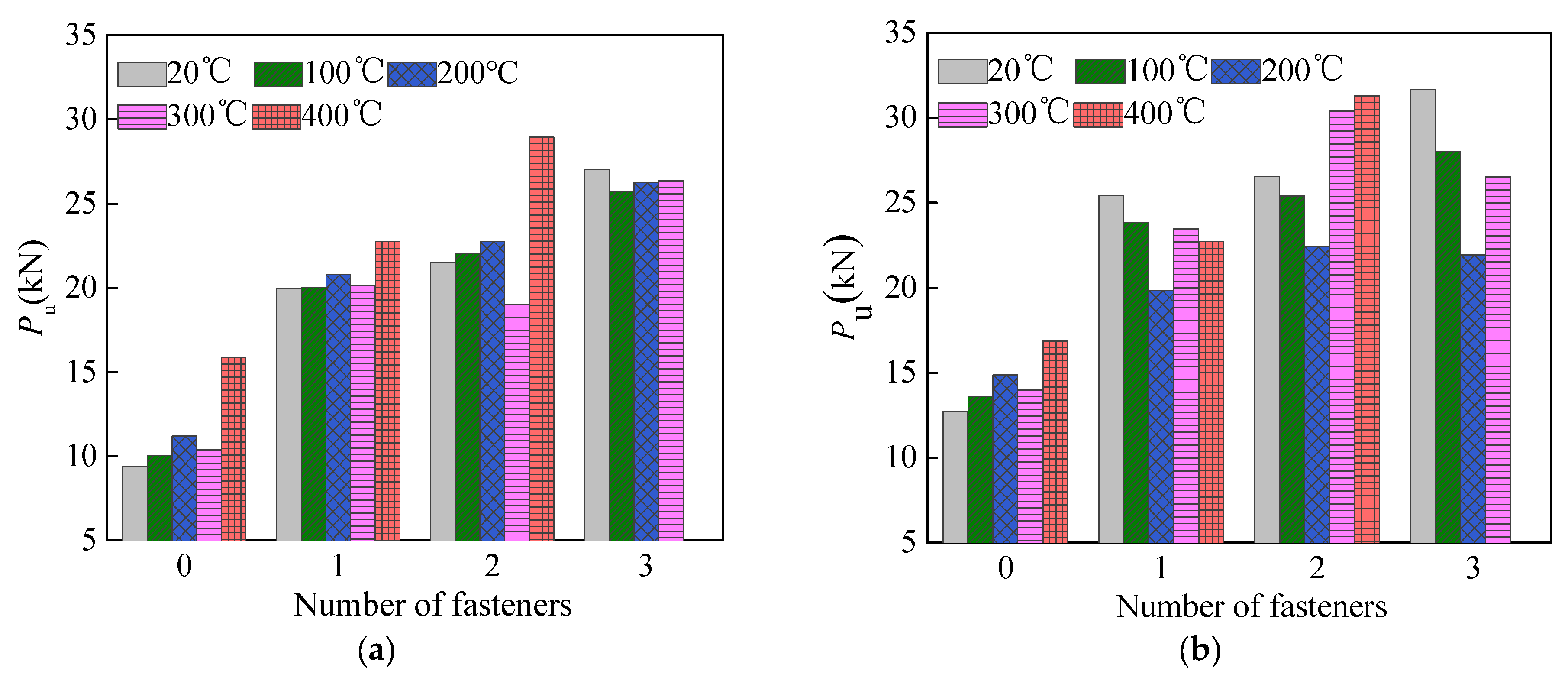Bonded Behavior of Hybrid-Bonded CFRP to Heat-Damaged Concrete Interface
Abstract
:1. Introduction
2. Experimental Program
2.1. Details of Test Specimens
2.2. Materials
2.3. Test Setup and Instruments
3. Results and Discussions
3.1. Failure Patterns
3.1.1. EB Specimens
3.1.2. HB Specimens
3.2. CFRP Strain Distribution
3.3. Ultimate Load
4. Bond Strength Analytical Model
4.1. Strength Analytical Model
4.1.1. CFRP Bonding
4.1.2. CFRP Bonding Combined with Bolt Fracture
4.1.3. Fracture of CFRP
4.2. Calibration of the Proposed Model
5. Conclusions
- (1)
- The exposed temperature and number of mechanical fasteners have an obvious effect on the failure mode of the HB-CFRP joints. After exposure to 400 °C, the HB-CFRP joints were prone to fail due to the shear-tension failure of the concrete that lost the shear strength. The increase in the number of mechanical fasteners changed the failure patterns of the single-layer HB-CFRP joints with unheated concrete from the debonding to the fracture of the CFRP, due to the increase in normal pressure on the bonded CFRP.
- (2)
- In comparison with the reference joints without fasteners, the utilization rate of single-layer CFRP joints with unheated concrete increased by 57.9%, 139.5%, and 136.8% when the number of mechanical fasteners increased to one, two, and three. Accordingly, the ultimate strength increased by 111.77%, 128.42%, and 186.74%.
- (3)
- The ultimate load of most EB- and HB-CFRP joints anchored with no more than three fasteners is higher than that of the reference joints when the exposed temperature is no more than 400 °C. However, the ultimate load of the HB-CFRP joints anchored with three fasteners decreases after exposure to high temperatures due to the loss of strength of heat-damaged concrete.
- (4)
- A predictive model for the bond strength of the HB-FRP joints with unheated and heat-damaged concrete interface was proposed. Its validity was verified by comparing the calculated with the measured bond strengths of a series of specimens tested by the authors and other researchers.
Author Contributions
Funding
Institutional Review Board Statement
Informed Consent Statement
Data Availability Statement
Conflicts of Interest
References
- Thongchom, C.; Lenwari, A.; Aboutaha, R.S. Effect of sustained service loading on post-fire flexural response of reinforced concrete T-beams. ACI Struct. J. 2019, 116, 243–254. [Google Scholar] [CrossRef]
- Yu, Y.; Hang, Z.; Zhao, W.; Zhao, X. Fire-resistance mechanism and residual bearing capacity of prestressed concrete beams after fire exposure. J. Struct. Eng. 2021, 147, 4021109. [Google Scholar] [CrossRef]
- Xu, Y.Y.; Chen, Y.X.; Yan, B.; Zhen, R.L.; Luo, Y. Post-fire seismic behaviors of concrete stub columns in different fire exposure cases. J. Vib. Shock. 2020, 39, 11–19. (In Chinese) [Google Scholar]
- Demir, U.; Unal, G.; Goksu, C.; Goksu, C.; Saribas, I.; Ilki, A. Post-fire seismic behavior of RC columns built with sustainable concrete. J. Earthq. Eng. 2022, 26, 6869–6892. [Google Scholar] [CrossRef]
- Liu, G.R.; Song, Y.P.; Qu, F.L. Post-fire cyclic behavior of reinforced concrete shear walls. J. Cent. South. Univ. T. 2010, 17, 1103–1108. [Google Scholar] [CrossRef]
- Timilsina, S.; Yazdani, N.; Beneberu, E. Post-fire analysis and numerical modeling of a fire-damaged concrete bridge. Eng. Struct. 2021, 244, 112764. [Google Scholar] [CrossRef]
- Liu, X.; Yu, C.; Quan, W.; Chen, L. Inspection, materials testing and field testing of a prestressed concrete box bridge after fire exposure. Fire. Safety. J. 2019, 108, 102852. [Google Scholar] [CrossRef]
- Zaman, A.; Gutub, S.A.; Wafa, M.A. A review on FRP composites applications and durability concerns in the construction sector. J. Reinf. Plast. Comp. 2013, 32, 1966–1988. [Google Scholar] [CrossRef]
- Mugahed Amran, Y.H.; Alyousef, R.; Rashid, R.S.M.; Alabduljabbar, H.; Hung, C.C. Properties and applications of FRP in strengthening RC structures: A review. Structures 2018, 16, 208–238. [Google Scholar] [CrossRef]
- Naser, M.Z.; Hawileh, R.A.; Abdalla, J.A. Fiber-reinforced polymer composites in strengthening reinforced concrete structures: A critical review. Eng. Struct. 2019, 198, 109542. [Google Scholar] [CrossRef]
- Wu, J.Y.; Zhu, Y.Q.; Li, C.G. Experimental investigation of fatigue capacity of bending-anchored CFRP cables. Polymers 2023, 15, 2483. [Google Scholar] [CrossRef]
- Xian, G.J.; Guo, R.; Li, C.G. Combined effects of sustained bending loading, water immersion and fiber hybrid mode on the mechanical properties of carbon/glass fiber reinforced polymer composite. Comp. Struct. 2022, 281, 115060. [Google Scholar] [CrossRef]
- Al-Nimry, H.S.; Haddad, R.H.; Afram, S.K.; Abdel-Halim, M.A. Effectiveness of advanced composites in repairing heat-damaged RC columns. Mater. Struct. 2013, 46, 1843–1860. [Google Scholar] [CrossRef]
- Al-Kamaki, Y.S.S.; Al-Mahaidi, R.; Bennetts, I. Experimental and numerical study of the behaviour of heat-damaged RC circular columns confined with CFRP fabric. Compos. Struct. 2015, 133, 679–690. [Google Scholar] [CrossRef]
- Kumar, H.; Maheswaran, C.; Agarwal, A.; Shanmugam, S.P. Effectiveness of hybrid fibre-reinforced polymer retrofitting on behaviour of fire damaged RC columns under axial compression. Eng. Struct. 2020, 211, 110458. [Google Scholar]
- Yu, J.T.; Yuan, L.; Lu, Z.D.; Kai, X. Flexural performance of fire damaged and rehabilitated two span reinforced concrete slabs and beams. Struct. Eng. Mech. 2012, 42, 799–813. [Google Scholar] [CrossRef]
- Xu, Q.; Chen, L.; Han, C.; Harries, K.A.; Xu, Z. Experimental research on fire-damaged RC continuous T-beams subsequently strengthened with CFRP sheets. Eng. Struct. 2019, 183, 135–149. [Google Scholar] [CrossRef]
- Abdulrahman, A.S.; Kadir, M.R.A. Behavior and flexural strength of fire-damaged high-strength reinforced rectangular concrete beams with tension or compression zones exposed to fire repaired with CFRP sheets. Case. Stud. Constr. Mat. 2021, 15, e00779. [Google Scholar] [CrossRef]
- Haddad, R.H.; Al-Rousan, R.; Almasry, A. Bond-slip behavior between carbon fiber reinforced polymer sheets and heat-damaged concrete. Compos. Part B-Eng. 2013, 45B, 1049–1060. [Google Scholar] [CrossRef]
- Xu, Y.; Lin, Y.; Dong, Y.; Zhang, D.; Shen, X. Experimental study on interface bond performance between CFRP and concrete after elevated temperature. J. Build. Struct. 2015, 36, 133–141. (In Chinese) [Google Scholar]
- Liu, G.R.; Qu, F.L.; Zhao, S.B.; Zhang, H.Y. Bond-slip behavior between CFRP sheets and heat-damaged concrete. J. Build. Struct. 2019, 40, 156–162. (In Chinese) [Google Scholar]
- Smith, S.; Teng, J. FRP-strengthened RC beams. I: Review of debonding strength models. Eng. Struct. 2002, 24, 385–395. [Google Scholar] [CrossRef]
- Teng, J.; Smith, S.; Yao, J.; Chen, J. Intermediate crack-induced debonding in RC beams and slabs. Constr. Build. Mater. 2003, 17, 447–462. [Google Scholar] [CrossRef]
- Fu, B.; Chen, G.; Teng, J. Mitigation of intermediate crack debonding in FRP-plated RC beams using FRP U-jackets. Compos. Struct. 2017, 176, 883–897. [Google Scholar] [CrossRef]
- Zhang, P.; Lei, D.; Ren, Q.; He, J.; Yang, Z. Experimental and numerical investigation of debonding process of the FRP plate-concrete interface. Constr. Build. Mater. 2019, 235, 117457. [Google Scholar] [CrossRef]
- Lamanna, A.J.; Bank, L.C.; Scott, D.W. Flexural strengthening of reinforced concrete beams using fasteners and fiber-reinforced polymer strips. ACI Struct. J. 2001, 98, 368–376. [Google Scholar]
- Bank, L.C.; Arora, D. Analysis of RC beams strengthened with mechanically fastened FRP (MF-FRP) strips. Compos. Struc. 2007, 79, 180–191. [Google Scholar] [CrossRef]
- Elsayed, W.E.; Ebead, U.A.; Neale, K.W. Studies on mechanically fastened fiber-reinforced polymer strengthening systems. ACI Struct. J. 2009, 106, 49–59. [Google Scholar]
- Wu, Y.F.; Huang, Y. Hybrid bonding of FRP to reinforced concrete structures. J. Compos. Constr. 2008, 12, 266–273. [Google Scholar] [CrossRef]
- Wu, Y.F.; Van, J.H.; Zhou, Y.W.; Xiao, V. Ultimate strength of reinforced concrete beams retrofitted with hybrid bonded fiber-reinforced polymer. ACI Struct. J. 2010, 107, 451–460. [Google Scholar]
- Wu, Y.F.; Wang, Z.; Kang, L.; Wei, H. Numerical analyses of hybrid-bonded FRP strengthened concrete beams. Comput-aided. Civ. Inf. 2010, 24, 371–384. [Google Scholar] [CrossRef]
- Guan, Y.H.; Jiang, B.S.; Song, X.G. Experimental study and numerical simulation on bonding behavior of the new HB-FRP strengthening technology. J. Perform. Constr. Fac. 2012, 26, 220–227. [Google Scholar] [CrossRef]
- Zhou, Y.W.; Wang, X.; Sui, L.; Xing, F.; Huang, Z.; Chen, C.; Li, P.; Mei, L. Effect of mechanical fastening pressure on the bond behaviors of hybrid-bonded FRP to concrete interface. Compos. Struct. 2018, 204, 731–744. [Google Scholar] [CrossRef]
- Wu, Y.F.; Liu, K. Characterization of mechanically enhanced FRP bonding system. J. Compos. Constr. 2013, 17, 34–49. [Google Scholar] [CrossRef]
- Chen, C.; Sui, L.; Xing, F.; Li, D.; Zhou, Y.; Li, P. Predicting bond behavior of HB FRP strengthened concrete structures subjected to different confining effects. Compos. Struct. 2018, 187, 212–225. [Google Scholar] [CrossRef]
- Gao, L.; Zhang, F.; Liu, J.; Lu, X.; Gao, H. Experimental and numerical study on the interfacial bonding characteristics of FRP-to-concrete joints with mechanical fastening. Constr. Build. Mater. 2018, 199, 456–470. [Google Scholar] [CrossRef]
- Xue, C.C.; Yu, M.; Xu, H.M.; Xu, L.H.; Saafi, M.; Ye, J.Q. Compressive performance and deterioration mechanism of ultra-high performance concrete with coarse aggregates under and after heating. J. Build. Eng. 2023, 64, 105502. [Google Scholar] [CrossRef]
- Kim, W.; Choi, H.; Lee, T. Residual compressive strength prediction model for concrete subject to high temperatures using ultrasonic pulse velocity. Materials. 2023, 16, 515. [Google Scholar] [CrossRef]
- Wu, Z.M.; Hu, C.H.; Wu, Y.F.; Zheng, J.J. Application of improved hybrid bonded FRP technique to FRP debonding prevention. Constr. Build. Mater. 2011, 25, 2898–2905. [Google Scholar] [CrossRef]
- Chen, J.F.; Teng, J.G. Anchorage strength models for FRP and steel plates bonded to concrete. J. Struct. Eng. 2001, 127, 784–791. [Google Scholar] [CrossRef]
- Chang, Y.F.; Chen, Y.H.; Sheu, M.S.; Yao, G.C. Residual stress-strain relationship for concrete after exposure to high temperatures. Cement. Concrete. Res. 2006, 36, 1999–2005. [Google Scholar] [CrossRef]







| Specimen | Exposure Temperature (°C) | Number of Fasteners | CFRP Layers | Pu (kN) | Standard Deviation | Failure Pattern | Utilization Rate (%) |
|---|---|---|---|---|---|---|---|
| EB-TAC1 | Ambient | 0 | 1 | 9.43 | 0.95 | D | 38 |
| EB-TAC2 | 0 | 2 | 12.70 | 0.35 | D | 29 | |
| HB-TAN1C1 | 1 | 1 | 19.97 | 1.81 | D | 60 | |
| HB-TAN1C2 | 1 | 2 | 25.43 | 0.90 | D + BF | 46 | |
| HB-TAN2C1 | 2 | 1 | 21.54 | 1.59 | CF | 91 | |
| HB-TAN2C2 | 2 | 2 | 26.53 | 0.67 | D + BF | 46 | |
| HB-TAN3C1 | 3 | 1 | 27.04 | 0.31 | CF | 90 | |
| HB-TAN3C2 | 3 | 2 | 31.68 | 2.20 | D + BF | 36 | |
| EB-T1C1 | 100 | 0 | 1 | 10.06 | 0.99 | D | 31 |
| EB-T1C2 | 0 | 2 | 13.60 | 0.47 | D | 20 | |
| HB-T1N1C1 | 1 | 1 | 20.05 | 1.98 | D + BF | 56 | |
| HB-T1N1C2 | 1 | 2 | 23.82 | 1.97 | D + BF | 32 | |
| HB-T1N2C1 | 2 | 1 | 22.05 | 1.61 | D + BF | 62 | |
| HB-T1N2C2 | 2 | 2 | 25.39 | 2.04 | D + BF | 28 | |
| HB-T1N3C1 | 3 | 1 | 25.71 | 1.66 | D + BF | 51 | |
| HB-T1N3C2 | 3 | 2 | 28.03 | 2.13 | D + BF | 39 | |
| EB-T2C1 | 200 | 0 | 1 | 11.20 | 0.20 | D | 34 |
| EB-T2C2 | 0 | 2 | 14.86 | 1.18 | D | 23 | |
| HB-T2N1C1 | 1 | 1 | 20.79 | 1.30 | D + BF | 53 | |
| HB-T2N1C2 | 1 | 2 | 19.93 | 0.51 | D + BF | 39 | |
| HB-T2N2C1 | 2 | 1 | 22.76 | 0.35 | D + BF | 49 | |
| HB-T2N2C2 | 2 | 2 | 22.41 | 1.26 | D + BF | 30 | |
| HB-T2N3C1 | 3 | 1 | 26.26 | 1.01 | CF | 88 | |
| HB-T2N3C2 | 3 | 2 | 21.93 | 2.82 | D + BF | 39 | |
| EB-T3C1 | 300 | 0 | 1 | 10.38 | 0.39 | D | 39 |
| EB-T3C2 | 0 | 2 | 13.99 | 1.00 | D | 25 | |
| HB-T3N1C1 | 1 | 1 | 20.13 | 1.89 | D + BF + CF | 86 | |
| HB-T3N1C2 | 1 | 2 | 23.47 | 0.28 | D | 29 | |
| HB-T3N2C1 | 2 | 1 | 19.03 | 1.10 | D + BF | 40 | |
| HB-T3N2C2 | 2 | 2 | 30.39 | 0.83 | D + BF | 37 | |
| HB-T3N3C1 | 3 | 1 | 26.38 | 0.83 | D + BF + CF | 75 | |
| HB-T3N3C2 | 3 | 2 | 26.53 | 0.83 | D + BF | 35 | |
| EB-T4C1 | 400 | 0 | 1 | 15.88 | 1.06 | D + CST | 40 |
| EB-T4C2 | 0 | 2 | 16.86 | 0.98 | D + CST | 31 | |
| HB-T4N1C1 | 1 | 1 | 22.76 | 2.16 | D + BF | 67 | |
| HB-T4N1C2 | 1 | 2 | 22.72 | 0.55 | D + BF | 32 | |
| HB-T4N2C1 | 2 | 1 | 28.97 | 0.28 | D + BF | 54 | |
| HB-T4N2C2 | 2 | 2 | 31.29 | 0.16 | D + CST | 32 |
Disclaimer/Publisher’s Note: The statements, opinions and data contained in all publications are solely those of the individual author(s) and contributor(s) and not of MDPI and/or the editor(s). MDPI and/or the editor(s) disclaim responsibility for any injury to people or property resulting from any ideas, methods, instructions or products referred to in the content. |
© 2023 by the authors. Licensee MDPI, Basel, Switzerland. This article is an open access article distributed under the terms and conditions of the Creative Commons Attribution (CC BY) license (https://creativecommons.org/licenses/by/4.0/).
Share and Cite
Liu, G.; Wang, Y.; Qu, F.; Guo, X.; Li, Y.; Cheng, S. Bonded Behavior of Hybrid-Bonded CFRP to Heat-Damaged Concrete Interface. Buildings 2023, 13, 2736. https://doi.org/10.3390/buildings13112736
Liu G, Wang Y, Qu F, Guo X, Li Y, Cheng S. Bonded Behavior of Hybrid-Bonded CFRP to Heat-Damaged Concrete Interface. Buildings. 2023; 13(11):2736. https://doi.org/10.3390/buildings13112736
Chicago/Turabian StyleLiu, Guirong, Yao Wang, Fulai Qu, Xu Guo, Yang Li, and Shengzhao Cheng. 2023. "Bonded Behavior of Hybrid-Bonded CFRP to Heat-Damaged Concrete Interface" Buildings 13, no. 11: 2736. https://doi.org/10.3390/buildings13112736
APA StyleLiu, G., Wang, Y., Qu, F., Guo, X., Li, Y., & Cheng, S. (2023). Bonded Behavior of Hybrid-Bonded CFRP to Heat-Damaged Concrete Interface. Buildings, 13(11), 2736. https://doi.org/10.3390/buildings13112736







